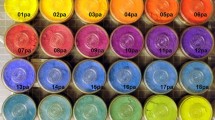Abstract
The mummification ritual in ancient Egypt involved the evisceration of the corpse and its desiccation using natron, a naturally occurring evaporitic mineral deposit from the Wadi Natrun, Egypt. The deposit typically contains sodium carbonate, sodium bicarbonate and impurities of chloride and sulfate as its major elemental components. It is believed that the function of the natron was to rapidly remove the water from the cadaver to prevent microbial attack associated with subsequent biological tissue degradation and putrefaction. Several specimens of natron that were recently collected from the Wadi Natrun contained coloured zones interspersed with the mineral matrix that are superficially reminiscent of extremophilic cyanobacterial colonisation found elsewhere in hot and cold deserts. Raman spectroscopy of these specimens using visible and near-infrared laser excitation has revealed not only the mineral composition of the natron, but also evidence for the presence of cyanobacterial colonies in several coloured zones observed in the mineral matrix. Key Raman biosignatures of carotenoids, scytonemin and chlorophyll have been identified.

The mummification ritual in ancient Egypt involved the evisceration of the corpse and its desiccation using natron, a naturally occurring evaporitic mineral deposit from the Wadi Natrun, Egypt. The deposit typically contains sodium carbonate, sodium bicarbonate and impurities of chloride and sulfate as its major elemental components. It is believed that the function of the natron was to rapidly remove the water from the cadaver to prevent microbial attack associated with subsequent biological tissue degradation and putrefaction. Several specimens of natron that were recently collected from the Wadi Natrun contained coloured zones interspersed with the mineral matrix that are superficially reminiscent of extremophilic cyanobacterial colonisation found elsewhere in hot and cold deserts. Raman spectroscopy of these specimens using visible and near-infrared laser excitation has revealed not only the mineral composition of the natron, but also evidence for the presence of cyanobacterial colonies in several coloured zones observed in the mineral matrix. Key Raman biosignatures of carotenoids, scytonemin and chlorophyll have been identified.








Similar content being viewed by others
References
David AR (1978) Mysteries of the mummies. Book Club Associates, London
Herodotus (1910) History, book II:86. Dent, London (transl. by Rawlinson G)
Cockburn A, Cockburn E, Reyman TA (1998) Mummies, disease and ancient cultures, 2nd edn. Cambridge University Press, Cambridge, pp 20–30
Mokhtar G, Riad H, Iskander S (1973) Mummification in ancient Egypt. Cairo Museum, Cairo
Lucas A (1962) Ancient Egyptian materials and industries, 4th edn. E. Arnold, London (rev., transl. by Harris JR)
Vitruvius (1999) The ten books on architecture. Cambridge University Press, Cambridge
Edwards HGM, Moody CD, Newton EM, Jorge Villar SE, Russell MJ (2005) Icarus 175:372–381
Edwards HGM, Mohsin MA, Sadooni FA, Nikhassan NF, Munshi T (2006) Anal Bioanal Chem 385:46–56
Edwards HGM, Jorge Villar SE, Parnell JA, Cockell CS, Lee P (2005) Analyst 130:917–923
Cockell CS, Knowland J (1999) Biol Rev 74:311–345
Wynn-Williams DD, Edwards HGM (2000) Icarus 144:486–503
Wynn-Williams DD, Edwards HGM (2000) Planet Space Sci 48:1065–1075
Wynn-Williams DD, Edwards HGM (2002) Environmental UV radiation: biological strategies for protection and avoidance. In: Horneck G, Baumstark-Khan C (eds) Astrobiology: the quest for the conditions of life. Springer, Berlin Heidelberg New York, pp 245–260
Wynn-Williams DD, Edwards HGM (2002) Int J Astrobiol 1:39–49
Veronelli M, Zerbi G, Stradi R (1995) J Raman Spectrosc 26:683–692
Withnall R, Chowdhury BZ, Silver J, Edwards HGM, de Oliveira LFC (2003) Spectrochim Acta Part A 59:2221–2246
Jorge Villar SE, Edwards HGM, Benning G (2006) Icarus 184:158–169
Edwards HGM, Moeller R, Jorge Villar SE, Horneck G, Stackebrandt E (2006) Int J Astrobiol 5:313–318
Shortland AJ (2004) Archaeometry 46:497–516
Falb M, Pfeiffer F, Palm P, Rodewald K, Hickmann V, Tittor J, Oesterhelt D (2005) Genome Res 15:1336–1343
Hamed AF (2005) Acta Botanica Hung 47:117–136
Author information
Authors and Affiliations
Corresponding author
Rights and permissions
About this article
Cite this article
Edwards, H.G.M., Currie, K.J., Ali, H.R.H. et al. Raman spectroscopy of natron: shedding light on ancient Egyptian mummification. Anal Bioanal Chem 388, 683–689 (2007). https://doi.org/10.1007/s00216-007-1249-4
Received:
Revised:
Accepted:
Published:
Issue Date:
DOI: https://doi.org/10.1007/s00216-007-1249-4




